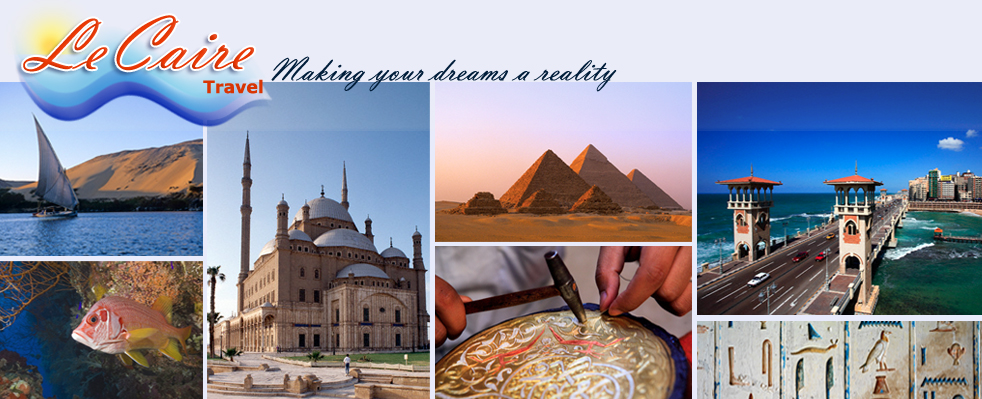|
|
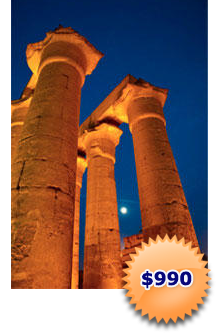 |
Superior Offer
09 Nights / 10 Days
Discover the Difference |
|
|
|
 |
| |
|
 |
Cairo Sightseeing
(03 Nights/04 Days)
|
|
 |
|
| |
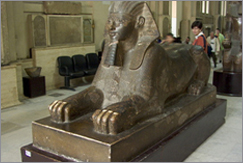 Egyptian Museum Egyptian Museum
More than 120,000 relics and antiquities from almost every period of ancient Egyptian history are housed in the Egyptian Museum in Cairo.
The nucleus of the collection was first gathered under one roof in Bulaq in 1858 by Auguste Mariette, the French archaeologist who had founded the Egyptian Antiquities Service. In 1878 the Bulaq Museum was flooded and many artifacts destroyed or stolen. The remaining objects were transferred in 1890 to an annex of the palace of Ismail Pasha at Giza, until the current museum was built in 1902. Since then the number of exhibits has completely outgrown the available space.
The exhibits are arranging chronologically from the Old Kingdom to the Roman Empire. Pride of the collection are the artifacts recovered from Tutankhamen's tomb. Who ruled Egypt for only nine years during the 14th century BC, were discovered by Howard Carter in 1922. Its well-hidden location in the Valley of the Kings, below the much grander but ransacked tomb of Ramses IV, had long prevented its discovery.
About 1700 items are spread throughout a series of rooms and although the gold shines brightest, it is the other, less grand objects that give an insight in the pharaoh's life.
Also some of 17th to 21st dynasties, 1650 to 945 the most amazing mummies are on display in the royal Mummy Room which houses the remains of 13 of Egypt's most illustrious pharaohs and queens from the BC. They lie in individual glass showcases (kept at a constant 22°C ) in a somber, dimly lit environment reminiscent of a tomb. Tour guides, photos are not allowed in, making it a peaceful haven.
Note: there is a separate fee to see the mummies, moreover, some young children might be scared by the Mummy Room and could suffer nightmares as a result. |
 
|
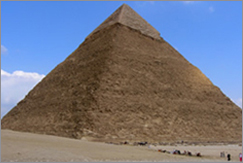 Pyramids
Pyramids
The great pyramids of Giza are just three of approximately 90 ancient pyramids spread along the Nile. The sole survivors of the ancient Seven Wonders of the World, the Pyramids are the planet's oldest tourist attraction. Built by generations of father, son and grandson, they were already more than 2500 years old at the time of the birth of Jesus Christ. The wonder of the Pyramids is in their age-old mysteries-how they were built and why?Egypt. Originally stood 479 ft (146 m) high, when it was completed in around 2570BC. After 46 centuries its height has been reduced by 9m because of the stripping of its original smooth limestone casing.
About 2.3 million limestone blocks, reckoned to weigh on average about 2.5 tons each, were used in the construction.
Although there is not much to see inside the Pyramid, the experience of climbing through the ancient structure is unforgettable, though completely impossible if you suffer even the tiniest degree of claustrophobia.
South of the great Pyramid is the Solar Barque Museum. Five long pits were found near the Great Pyramid of Khufu. These once contained the pharaoh's solar barques, which may have been used to bring the mummy of the dead pharaoh across the Nile to the valley temple, then it was buried around the pyramid to provide transport for the pharaoh in the next world.
The Pyramid of Khafre (Chephren), to the southwest of the great pyramid, it seems larger than that of his father, Khufu. At 136m high, it's not, but appears that way because it stands on higher ground and its peak is still capped with a limestone casing.
Originally all the pyramids were totally encased with a polished white limestone casing. They would have gleamed like giant crystals.
The southernmost Pyramid of Menkaure (Mycerinus), at a height of 62m is the smallest of the great trio. son of Khafre and the fifth king of the Fourth Dynasty. Each side measures 356 ft (109 m), and the structure's completed height was 218 ft (66 m).
|
 
|
 Sphinx Sphinx
Legends and superstitions abound about the Sphinx, and the mystery surrounding its long-forgotten purpose is almost as intriguing as its appearance.
Known in Arabic as Abu al-Hol (father of terror), the feline man was called sphinx by the ancient Greeks because it resembled the mythical winged monster with a woman's head and lion's body who set riddles and killed anyone unable to answer them.
Carved from the natural bedrock at the bottom of the causeway to the pyramid of Khafre, a recent geological and archaeological survey has shown that the sphinx was most likely to have been carved during this particular pharaoh's reign and it probably portrays his features. |
 
|
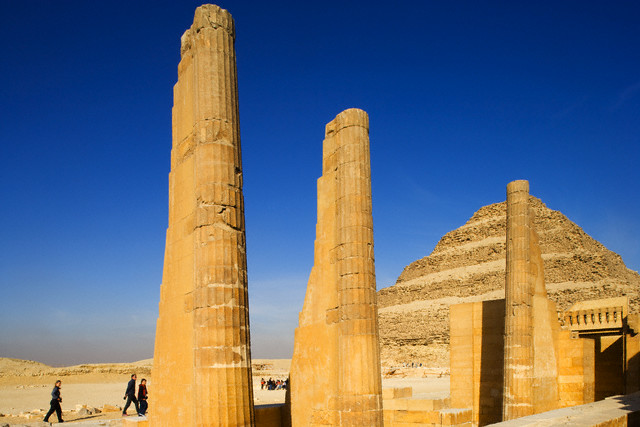 Sakkara Sakkara
The huge cemetery of ancient Memphis, was an active burial ground for more than 3500 years. The necropolis is situated high above the Nile valley's cultivation area, covering a 7km stretch of the western desert.
Deceased pharaohs and their families, administrators, generals and sacred animals were all interred here.
Old Kingdom pharaohs were buried within Saqqara's 11 major pyramids. The main monuments are in the area around the step pyramid. |
 
|
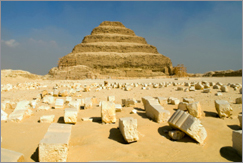 Step Pyramid Step Pyramid
The Step Pyramid of Djoser (also spelled Djozer or Zoser)
Imhotep, the pharaoh's chief architect (later deified), built the step pyramid 2650BC for zoser, as Egypt's and the world's earliest stone monument. Its significance cannot be overstated. The pyramid was transformed from mastaba into pyramid through six separate stages of construction and alteration. With each stage, the builders gained confidence in their use of the new medium and mastered the techniques required to move, place and secure the huge blocks. This first pyramid rose in six steps to a height of 60m and was encased in fine white limestone.
Mereruka's Mastaba is the largest mastaba (flat-topped tomb) in Saqqara, best known for its interior reliefs and murals.
The mastaba dates from the 6th Dynasty (2323-2150 BC) in the Old Kingdom period. It was built for Mereruka, the vizier to Pharaoh Teti (whose pyramid is next door), his wife Watethathor and his son Meryteti.
Excavations of Mereruka's Mastaba began in 1892 under Jacques de Morgan. |
 
|
 Memphis Memphis
Memphis, ancient capital of Egypt, was founded by the legendary pharaoh Menes who unified the two lands of Egypt around 3100 BC, it was founded on the exact spot where the Nile delta met the valley. Indeed, the city was filled with palaces, gardens and temples, making it one of the greatest cities of the ancient world. Even after Thebes became the new capital during the new kingdom, Memphis remained Egypt's second city; it was finally abandoned after the first Muslim invasions in the 7th century AD.
Centuries of builders quarrying for stone, of annual floods and of antiquity hunters have succeeded where even the mighty Persian failed: Memphis has almost completely vanished. Even the enormous temple of the creator god ptah, is now little more than a few sparse ruins frequently waterlogged due to the high water table.
All of which means that today there are few clues as to Memphis' former grandeur and importance, part of which is open-air, is built around a fallen colossal limestone statue of Ramses II, outside an alabaster sphinx of the new kingdom, moreover, other statues of Ramses II. |
 
|
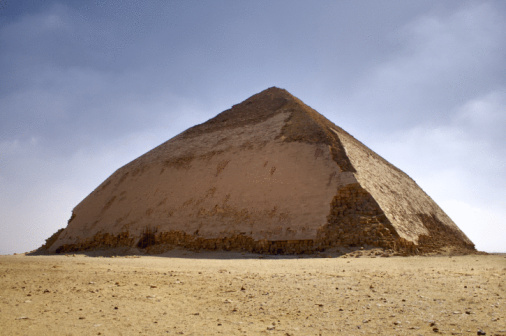 Dahshur Dahshur
About 10 km south of Saqqara, in a quiet bit of desert, Dahshur is an impressive 3.5km-long field of the 4th and the 12th dynasty pyramids.
There were originally 11 pyramids at Dahshur, although only the two old kingdom ones (the bent and the red) remain intact, the three middle kingdom pyramid complexes built by Amenemhat II (1922-1878 BC), sesostris III (1874-1855 BC) and his son Amenemhat III (1855-1808 BC), only the oddly shaped Black pyramid of Amenemhat III is worth a look.
Pharaoh Sneferu 2613-2589 BC, father of Cheops and the founder of the 4th dynasty built Egypt's first true pyramid here, the red pyramid. He also built an earlier version, the bent pyramid. These two pyramids were the same height. They are also the 3rd largest pyramids in Egypt, after the two largest at Giza.
The North Pyramid is known as the Red Pyramid for its pinkish limestone, it is one of the few whose interior is open to visitors. |
 
|
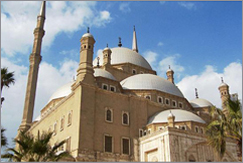 Citadel Citadel
Home to Egypt's rulers for almost 700 years, the citadel is today one of the most popular tourist sites in Cairo.
Originally founded in 1176 by the famed Muslim commander Saladin, its mosques, museums, and battlements reflect a diverse heritage. Divided into three sections, the citadel's main tourist area is in the southern enclosure, where the mosque of an-Nasr Mohammed (the citadel's only surviving Mamluk structure) is dwarfed by the 19th century Mosque of Mohammed Ali. The upper terraces of the citadel offer spectacular views over the city. |
 
|
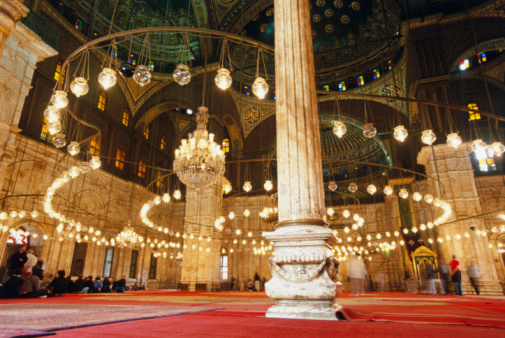 Mosque of Mohammed Ali Mosque of Mohammed Ali
It is the citadel's main attraction, dominating the eastern Cairo skyline; the Mohammed Ali Mosque is a relative newcomer, having been constructed as recently as the mid 19th century. It was erected on the orders of the reformist ruler Mohammed Ali, who is regarded as the founder of modern Egypt. When he came in power in 1805, Egypt was a backwater province of the Ottoman Empire. By the time of his death 1849, however the country was once again a regional superpower.
Mohammed Ali's imposing mosque was a grand gesture that was meant to echo the imperial mosques of the Ottoman capital. It is modeled along classic Turkish lines, with a great central dome and two towering, yet slender, minarets. |
 
|
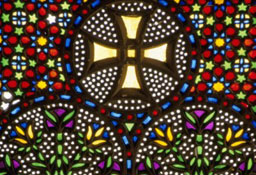 Coptic Museum Coptic Museum
Largely built in 1947, this charming museum houses the finest collection of Coptic art in the world. The building itself boasts elaborately painted wooding ceilings, elegant mashrabiyya windows, and a garden courtyard. The exhibits date to back to Egypt's Christian era and Pharaonic and Islamic influences are evident in the artifacts on display. |
 
|
 Hanging Church
Hanging Church
Dedicated to the virgin Mary, is called the Hanging church because it was built on top of the water gate of the old Roman fortress of Babylon.
The original structure was built possibly as early as the 4th century AD, but it was destroyed and rebuilt in the 11th century.
Expansion and reconstruction has gone on ever since, making it very difficult to date precisely any specific part of the church. The façade surmounted by its distinctive twin bell towers, the whole front section is a relatively recent addition, dating only from the 19th century. Outer porch of the church is decorated with glazed tiles in geometrical designs, the porch dates from the 11th century. Interior of the church there are three barrel-vaulted roofs are supported on columns with Corinthian capitals, indicating that they were recycled from earlier buildings. Also there are icons of St, George, the Virgin and John the Baptism adorn the walls.
Sanctuary screen is the star features of the church, carved from cedar wood and delicately inlaid with ivory, the central screen that shields the main alter is the finest of its kind in Egypt. The church is still used for regular public services, which are held every Friday and Sunday morning.
|
 
|
 Church of St. George
Church of St. George
Long before the Crusaders carried tales of his legendary exploits back to Europe, St, George was venerated throughout the Christian Middle East as mar Girgis.
He is said to have been a Roman legionary who defied a decree by the Emperor Diocletian outlawing the worship of the Christ and martyred for his beliefs some time in the third century.
There has been a church dedicated to St George on or near the present site since at least the 10th century, but today is striking round structure dates only to the beginning if the 20th century.
The circle form of the church echoes the shape of the 1st century AD Roman gate tower on top of which it was built.
The remains of the tower are still visible beneath the church on the north side and previous floodwater has been drained.
|
 
|
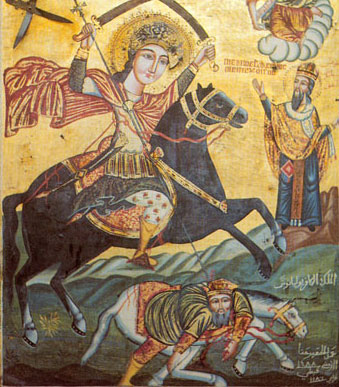 St. Mercurius Church St. Mercurius Church
St. Mercurius Church (also known as Abu Seifien) in Cairo, dedicated to the Coptic "saint of the two swords," was built in the 6th century and underwent intensive restoration during the 12th century. It is in the heart of Coptic Cairo but off the beaten tourist track, allowing for more atmosphere and quiet than can often be had in the Hanging Church.
According to legend, Mercurius was given a sword by an angel in order to fight against the barbarians in the 3rd century. He was martyred, but he later appeared to Emperor Julian the Apostate during a battle against the Persians and pierced him with a sword. Mercurius is always represented in Coptic art as a horseman holding two swords.
The Church of St. Mercurius consists of two churches one on top of the other, with many little side chapels dedicated to various saints. The pulpit is one of the most beautiful in Cairo, decorated with mosaic and supported by 15 marble columns. A door in the north aisle of the main church leads into a courtyard with a baptistery and three sanctuaries. Fine frescoes were recently discovered in the southern gallery of the upper church, and are being restored. |
 
|
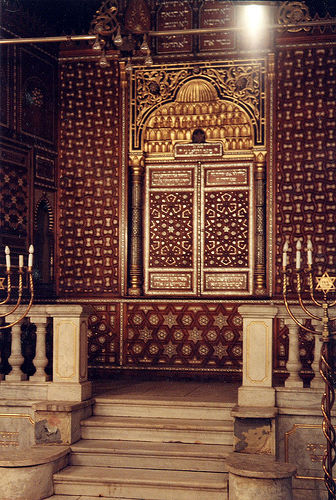 Ben Ezra Synagogue Ben Ezra Synagogue
Jewish history in Egypt dates back to the era of the old testament and the stories of Moses and the persecution of the Pharaohs, after the roman expulsion of Jews from Jerusalem in the 1st century AD, Alexandria became the world's most important center of Judaism. As recently as the early 20th century the Jewish community in Egypt remained significant and prominent. This change dramatically with the creation of Israel in 1948.
Those Jews that hadn't already left by choice were forced out of Egypt when the country went to war against the newly formed Jewish state.
Monuments to the long Jewish history in Egypt are few and of these, Ben Ezra is the oldest. Legends link it to Moses but in fact the Synagogue was formerly a church, built in the 8th century. Around 300 years later the church was destroyed and the site and its ruins given to Abraham Ben Ezra, a 12th century rabbi of Jerusalem.
Repairs in the 19th century unearthed hundreds of Hebrew manuscripts from the synagogue's intact geniza, or treasury. It is no longer used for worship it is in a pristine state. |
 
|
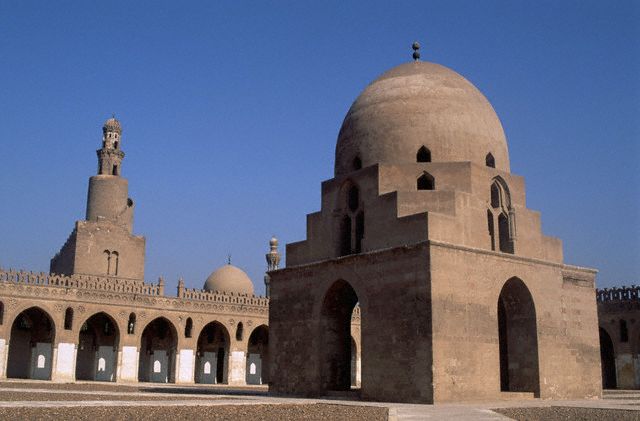 Ibn Tulun Mosque Ibn Tulun Mosque
one of the largest and oldest mosques in Egypt, ibn tulun was built between AD 876and AD 879 by an Abbasid governor sent from Baghdad to rule Egypt.
It is called the Friday mosque, its open air courtyard is large enough to hold the whole male congregation of the district for the prayers on the holiest day of the week.
The spiral minaret is the star feature of the mosque, inspired by the tower at the Great mosque of Samarra in Iraq, it is an easy climb, rewarded by excellent views of the city.
Also next there is Gayer-Anderson museum, is charming one , is the legacy of john gayer Anderson, a British officer serving in cairo.
In 1930s, he lovingly restored two adjacent 16th- or 17th century houses. Lavishly decorated with mashrabbiyya screens and marble inlays, he also added a room decorated by gold and lacquer taken from the 17th century house in Damascus. The cumulative effect of all these items makes the museum one of the most magical places to visit in Cairo. |
 
|
 Sultan Hassan Mosque Sultan Hassan Mosque
One of the most interesting of the capital's mosques, this also Cairo's finest example of early Mamluk architecture, the dimensions of this massive structure are truly staggering. 150m long with walls 36m high, the tallest minaret rising to 68m.
The construction of the mosque was funded money from the estates of people who had died in the Black Death (which struck Cairo in 1348). Building work began in 1356 and five years later, in 1361 one of the minarets collapsed, killing hundreds of people. These turned out to be a bad omen.
Despite the unhappy history of Hassan's grand monument, the interior of the mosque is overwhelming. Through a magnificent portal, a dimly lit corridor leads to a high-walled central courtyard are great, recessed arches, known as iwans, which were formerly used for teaching. |
 
|
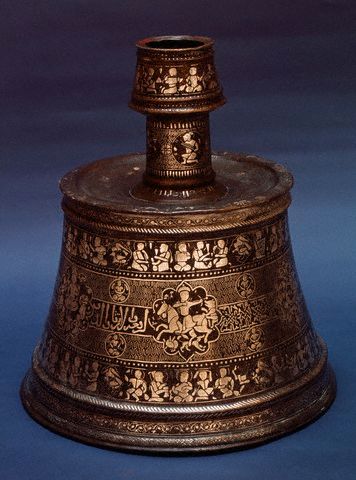 Museum of Islamic Arts Museum of Islamic Arts
Museum of Islamic Arts is one of the finest museums in the city.
The museum's extensive collection of over 10,000 pieces includes mainly Egyptian art, but there are pieces from elsewhere in the Islamic world as well.
Arranged according to medium, the exhibits illustrate every era of development, from Ummayad to Abbasid, Fatimid, Ayyubid, and Mamluk works.
The artworks include woodwork, stucco, intarsia, ceramics, glass, metalwork, textiles, and carpets. |
 
|
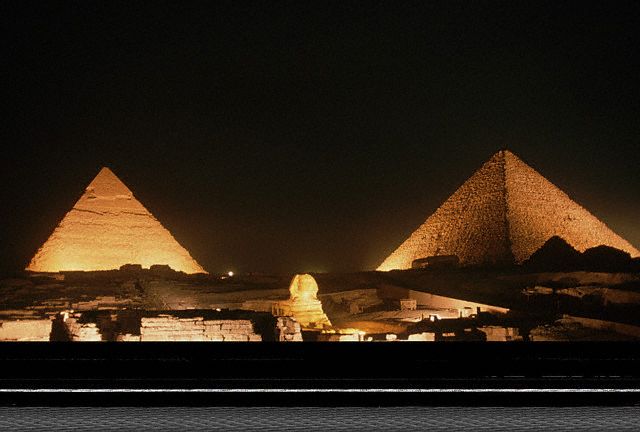 Sound & Light Show at Pyramids Sound & Light Show at Pyramids
The Show consists of a recorded commentary which tells the story of the Egyptians. The commentary is illustrated by still images (photos and illustrations) projected on to the wall of the temple. At key points in the narrative, one or more of the pyramids is illuminated with a coloured floodlight. Recorded music is also used. There are no live musicians or actors.
The only animation is when the Sphinx speaks, which is quite impressive. Thanks to a clever projection, the face of the Sphinx comes alive as you hear the words of a long-dead Pharaoh. It's a pity that moving images aren't used more in the rest of the show. |
 
|
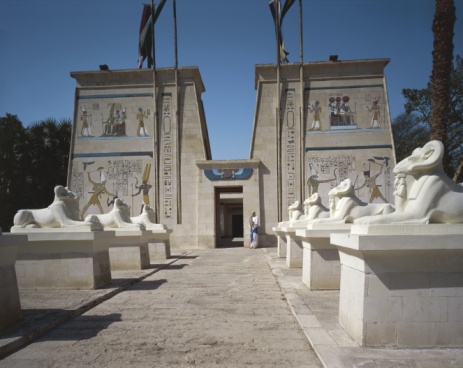 Pharaonic village Pharaonic village
The Pharaonic village has recently changed its concept it new offers museums, which cover Egypt's 5000 year of history. This includes a Nile Trip in Village Harbor, to see Pyramid & Sphinx , Mummification Exhibit, Tomb of Tut ankh amun, Ancient Arts , Coptic Exhibit, , Cleopatra's Studio , Islamic Exhibit , Napoleon's Exhibit , Nasser's Exhibit , , Anwar El Sadat Exhibit. |
 
|
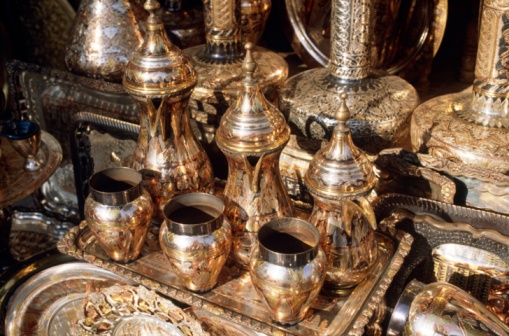 Khan EL Khalili Bazaar Khan EL Khalili Bazaar
The Khan El-Khalili is one of the most interesting bazaars, not only in Egypt, but also in the whole Middle East.
It was named after Prince Jaharkas Al-Khalili, who was one of the powerful Mamluke Princes in the 14th century. It is famous for its unusual, typically oriental souvenirs, and handmade crafts. The Medieval atmospheres of this traditional market, together with the labyrinth layout of the streets, gives visitors o lot of pleasure and a glimpse into what medieval markets once were like.
Cafes, restaurants, shops, and large number of vendors and buyers constitute a dynamic panorama of the place. Drinking Hibiscus, Karakare, Helba, or any of the various typical Egyptian beverages, is a pleasant experience for visitors and guests to get a real taste experience. For smokers, there is the Shisha, or water pipe, to be tried.
Every visitor can take the opportunity to safely enjoy the walk through the narrow streets of Khan El-Khalili |
|
|
|
|
|
|
|
|
 |
|
